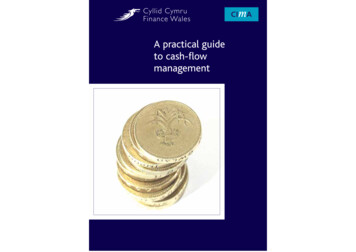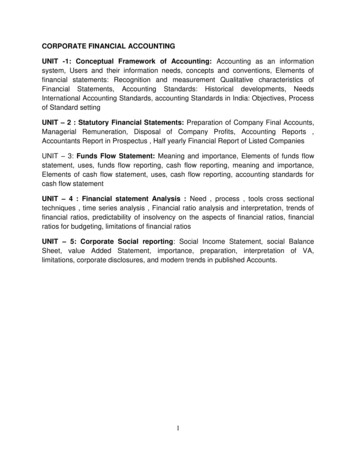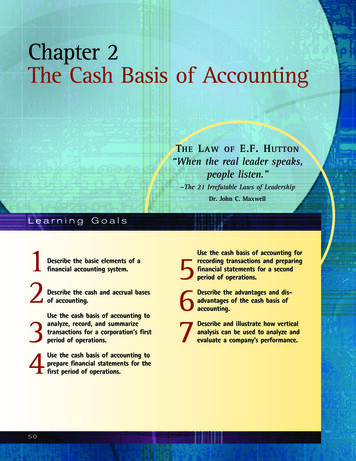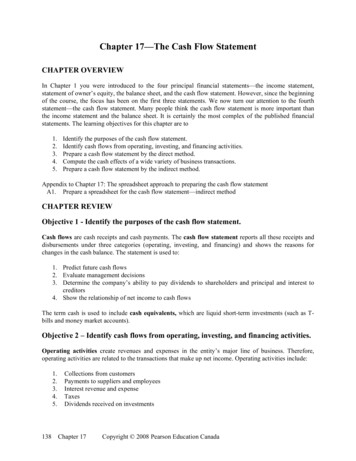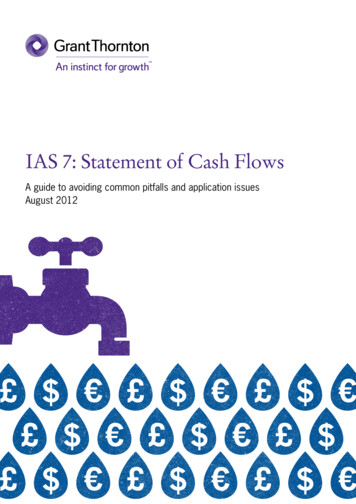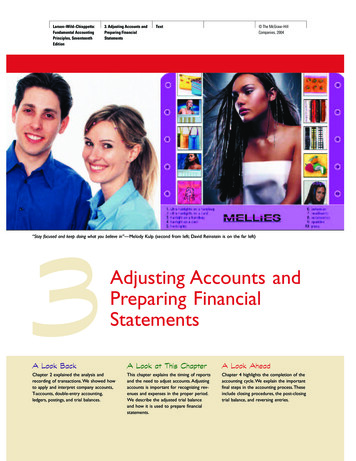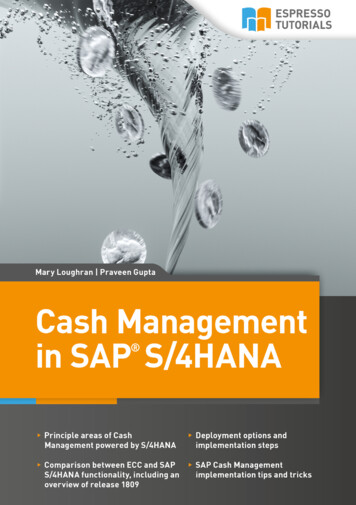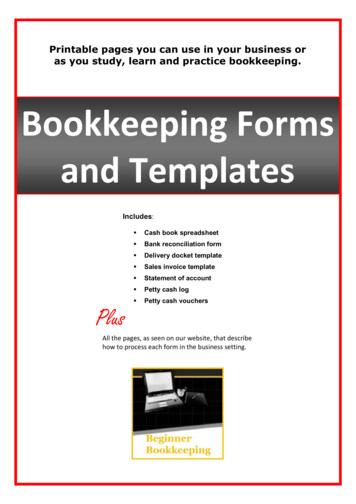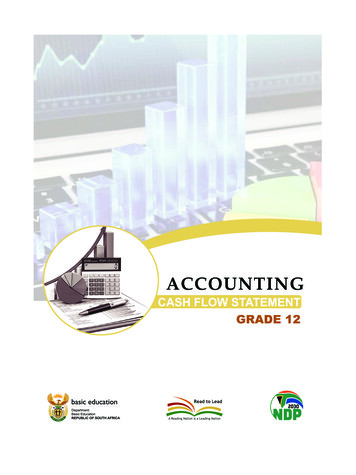
Transcription
Table of ContentsPage1.How to use this study guide32.Study and examination tips43.Overview of the topic54.Topic: Cash Flow Statement54.1Cash effect from operating activities64.2Cash effect from investing activities134.3Cash effect from financing activities164.4Cash and cash equivalents (Balance Sheet note)194.5Activities225.Check your answers366.Message to Grade 12 learners from the writers417.Thank you421DBE February 2019 GR15 Accountingv2.indd 14/4/2019 11:01:53 PM
1. How to use this study guideThe main intention of this study guide is to address challenges with specific areas of subjectcontent that was poorly answered in past NSC papers. This is informed by the detailed analysisdone on each question and the findings that were provided in the Diagnostic Report.The material presented in this booklet focuses on the progression and content overlap acrossthe FET phase, as illustrated in the table below.FieldGrade 12Grade 10 & 11Bookkeeping (sole trader)FinancialCompanies Concepts and bookkeepingFinancial StatementsCash Flow, Ratios (analysis and interpretation) AdjustmentsFinancial StatementsRatios/ InterpretationReconciliations prepareReconciliations analysisBank, Debtors and CreditorsVAT concepts and calculationsVATManagerialManufacturing concerns ManufacturingProduction Cost StatementUnit cost calculations and break-evenanalysisConcepts and ledger accountsBreak-even analysisBudgeting (prepare)Budgeting (analysis)Managing Resources Projected Income StatementCash Budget Stock valuationFIFO, weighted average and specific identification Fixed asset management (analysis) Auditing, internal controls and ethics Concepts and preparationBasic calculations Stock (clubs)Perpetual and periodic Fixed assets (prepare)Depreciation, disposal Auditing, internal controlsand ethicsIt is important to first address prior knowledge (concepts, calculations), before moving to themore challenging matters of analysing, interpreting and commenting. The next logical step is totackle examination type questions with the knowledge that all questions will cater for the different cognitive levels.This study guide provides:ooooNotes on simple definitions, explanations, formulae and short-cuts (handy hints).Focus-activities to test specific skills.Application activities in the form of examination-type questions.Adapted questions from past examination papers.2DBE February 2019 GR15 Accountingv2.indd 24/4/2019 11:01:54 PM
Plan of action:o Master the basic skills by using this manual, together with all other resources, if morepractice is needed.o Test your knowledge by attempting to do some examination questions.o Make a note of your shortcomings and go back to the drawing board.2.Study and Examination TipsKnow the paper: General structure and layouto One 3-hour paper for 300 marks;o The paper consists of 6 compulsory questions; the marks per question range from 30to 80 marks. Each question will comprise a number of sub-questions that are set atdifferent cognitive levels.o The content covered must conform to the requirements of CAPS, as follows:Financial AccountingManagerial AccountingManaging Resources50% - 60%20% - 25%20% - 25%150 – 180 marks60 – 75 marks60 – 75 marksThe trend in past papers was as follows:o Question 1, 2 and 6 are generally shorter questions (30 – 45 marks).o Question 3 and 4 are generally longer questions, comprising Financial Statementsand the Cash Flow Statement.o The question paper comes with a specially prepared ANSWER BOOK, which meansyou can answer the questions in any order.Strategy:Cash Flow Statement is part of Financial Accounting. Together with Income Statement, Balance sheet and Notes to the Financial Statement, it must constitute 50% –60% of the paper.Past trends show that it is normally Question 4 or 5 and is 60 – 75 marks, togetherwith analysis and interpretation.Examiners will sometimes ask you to complete the Cash Flow Statement, calculatesome figures (like Tax Paid) and prepare some parts of the Cash Flow Statement.The past trend shows that it is seldom that you will be asked to do a full Cash FlowStatement.(Detailed explanations are provided in Section 5 of this document).The Cash Flow Statement requires good knowledge and understanding of the principles of Inflows and Outflows, i.e. how these affect the cash movement in the company.These skills are developed in Grade 10, where Cash Receipts Journal (Inflow) andCash Payments Journal (Outflow) are introducedKnowledge of the company as a form of ownership is important to understand thechanges from other forms.3DBE February 2019 GR15 Accountingv2.indd 34/4/2019 11:01:54 PM
DBE February 2019 GR15 Accountingv2.indd 44/4/2019 11:01:54 PM
4.1Cash effect from Operating ActivitiesExample:Information:Extract from the Income Statement for the year ended 28 February 2018Net profit before tax300 000Income tax135 000Interest on loan92 000Depreciation120 000Extract from the Balance Sheet on 28 February 201820182017Trading stock600 000520 000Trade and other receivables230 000286 000Trade and other payables300 000272 000SARS (income tax)12 00016 000Shareholders for dividends60 00045 000Total dividends for the year amounts to R100 000, as per the note to Retained Income.Operating activitiesare the main income-earning activities of a company. They are directlySolutionrelated to the main objective of a company and must be considered in a broad sense. The cashNote 1: Cash generated from operationsgenerated by operatingactivitiesis perhaps the most300significantindicator of a company’s sucNet Profit beforetax000Add: relatesDepreciation120 000cess, because thisto the main purpose of establishingthe company. Examples of operInterest expense000ating activities Add:are:buying and selling stock; paying 92creditors;receiving payment from debtors;Sub-total512 000paying all the expenses,wages,Net changes e.g.in workingcapitalsalaries, telephone,(4 000)motor vehicle expenses; paying SARSChangein inventory(80 000)thetax due; payingshareholdersa dividend.000 – 520 000)- outflowThe items in the(600CFSare not cashflows, but “reasons why cash flow is different from profit.”56 000Change in receivablesDepreciation expense is a non-cash item that reduces profit, but does not impact cash flow.28 000Change in payablesHence, it is addedback.(286 000 – 230 000)(300 000 – 272 000)- inflow- inflowCashprofitgeneratedfrom operations508 000If the starting pointis aboveinterest and tax in theincome statement, then interest and idandtaxpaid:cash flows will need to be deducted if they are to be treatedas operating cash flows.CASH FLOWAmount in financial statements Amount owing at beginning of yearSTATEMENTFOR THE YEAR- Amount owing at end of yearTaxation135 00016 000ENDED (12 000) AmountpaidCash flow fromoperatingactivitiesCash generated from operationsInterest paid Amount in financial statements(Total dividends for the year)Dividends paid Amount owing at beginning of yearTaxation paid- Amount owing at end of yearAmount paidCash flow from investingactivitiesCash flow from financing activitiesDividends100 000Note 145 000(60 000)85 0006Net change in cash and cash equivalentsNote 1: Cash generated from operationsNet profit for the yearxxx Depreciationxxx Interest expensexxxSub-totalxxxNet change in working capitalxxx(Increase) / Decrease in inventoryxxx(Increase) / Decrease in receivablesxxxIncrease / (Decrease) in payablesxxxDBE February 2019 GR15 Accountingv2.indd 6Cash generated from operations?( ? )( ? )( ? )139 000xxx3/24/2019 11:34:59 AMXXXXXXXXXStart with this figure from IS.Add back non-cash item.Add back non-operating expense.These amounts can be with or without brackets, depending on the effect on the cash of thebusiness, i.e. whether there was an inflow oroutflow of cash.This figure will be used in the CFS.Example:5DBE February 2019 GR15 Accountingv2.indd 54/4/2019 11:01:54 PM
Information:Extract from the Income Statement for the year ended 28 February 2018Net profit before tax300 000Income tax135 000Interest on loan92 000Depreciation120 000Extract from the Balance Sheet on 28 February 201820182017Trading stock600 000520 000Trade and other receivables230 000286 000Trade and other payables300 000272 000SARS (income tax)12 00016 000Shareholders for dividends60 00045 000Total dividends for the year amounts to R100 000, as per the note to Retained Income.SolutionNote 1: Cash generated from operationsNet Profit before taxAdd: DepreciationAdd: Interest expenseSub-totalNet changes in working capitalChange in inventory(600 000 – 520 000)300 000120 00092 000512 000(4 000)(80 000)- outflow56 000Change in receivables(286 000 – 230 000)- inflow28 000Change in payables(300 000 – 272 000)- inflowCash generated from operations508 000We can use the following table to calculate dividends paid and tax paid:Amount in financial statements Amount owing at beginning of year- Amount owing at end of yearTaxation135 00016 000(12 000) Amount paid139 000Amount in financial statementsDividends100 000(Total dividends for the year) Amount owing at beginning of year- Amount owing at end of year45 000(60 000) Amount paid85 0006DBE February 2019 GR15 Accountingv2.indd 64/4/2019 11:01:55 PM
CASH FLOW STATEMENT FOR THE YEAR ENDING Cash flow from operating activitiesCash generated from operationsNote 1Interest paidDividends paid (100 000 45 000 – 60 000)Taxation paid (135 000 16 000 – 12 000)225 000508 000(92 000)(85 000)(139 000)Let us practiceThe information relate to Dean Ltd for the year ended 28 February 2018.REQUIRED: Complete the note for “Cash generated from operations”. Complete the section on “Cash flow from operating activities”.INFORMATION:A. Extract from the Income Statement for the year ended February 2018:Interest expenseDepreciationIncome Tax (30% of Net Profit before tax)R12 500R29 000R87 000B. Extract from the Balance Sheet:2018InventoryTrading stockConsumable stores on handTrade and other receivablesTrade debtorsPrepaid expensesTrade and other payablesTrade creditorsShareholder dividendsSARS (income tax)Accrued expensesIncome received in advance2017R200 000R3 000R203 000R230 000R5 000R235 000R41 000R1 500R42 500R25 000R1 500R26 500R35 000R110 000R8 500R4 000R3 500R161 000R46 500R54 000R5 000R5 500R7 500R118 5007DBE February 2019 GR15 Accountingv2.indd 74/4/2019 11:01:55 PM
C.The Retained Income note showed total ordinary share dividends of R180 000.Note 1: Cash generated from operationsNet Profit before taxAdd: DepreciationAdd: Interest expenseSub-totalNet changes in working capitalChange in inventoryChange in receivablesChange in payablesCash generated from operationsCASH FLOW STATEMENT FOR THE YEAR ENDING Cash flow from operating activitiesCash generated from operationsNote 1Interest paidDividends paidTaxation paidSolutionNote 1: Cash generated from operationsNet Profit before taxAdd: DepreciationAdd: Interest expenseSub-totalNet changes in working capitalChange in inventory (235 000 – 203 000) - inflowChange in receivables (42 500 – 26 500) - outflowChange in payables (59 500 – 42500)- outflowCash generated from operations290 00029 00012 500331500(1 000)32 000(16 000)(17 000)330500CASH FLOW STATEMENT FOR THE YEAR ENDING Cash flow from operating activitiesCash generated from operationsNote 1Interest paidDividends paid (54 000 70 000)Taxation paid (87 000 5 000 – 8500)110 500330 500(12 500)(124 000)(83 500)8DBE February 2019 GR15 Accountingv2.indd 84/4/2019 11:01:55 PM
4.2Cash Flow from Investing ActivitiesInvesting activity involves the establishment of the infrastructure of a company in order for it tobe in a position to earn income. Examples of investing activities include: investing in landand buildings (e.g. shop premises, which results in earning income because ofhaving a place forcustomers to buy goods or services); fixed deposit (generates income through interest).CASH FLOW STATEMENT FOR THE YEAR ENDING Cash flow from operating activitiesXXXCash flow from investing activitiesPurchase of fixed assetsProceeds from sale of assetsIncrease / Decrease in investments?Cash flow from financing activitiesXXXNet change in cash and cash equivalentsCash and cash equivalents at beginning of yearCash and cash equivalents at end of yearXXXXXXXXXUse the following format to identify changes to fixed assets (summary of note):FA Fixed Assets; BS Balance Sheet; IS Income Statement.FA at beginning of year FA purchased– FA sold (at book value)– Depreciation for the year FA at end of yearXXXXXXThis figure comes from the BSYear 1.Add:You will be able to calculate one ofthese figures as a missing figure neededLess: XXX for the preparation of the CFS.Less: XXXThis figure comes from the IS.XXXThis figure comes from the BS - Year 2.*Can be shown in the form of an equation.Example:You are provided with the following information from the financial statements.Complete the appropriate extract from the Cash Flow Statement.Year 2770 000650 000120 000NON-CURRENT ASSETSFixed AssetsInvestment in fixed depositYear 1480 000430 00050 000Note: The Income Statement reflects depreciation of R35 000. Fixed assets were sold at carrying value for R22 000.9DBE February 2019 GR15 Accountingv2.indd 94/4/2019 11:01:55 PM
Solution:Calculate the amount for fixed assets purchased, as follows:Fixed assets at beginning of year Fixed assets purchased- Fixed assets sold (carrying value)- Depreciation- Fixed assets at end of year430 000missing figure(22 000)(35 000)650 000Calculation of the missing figure:Extract from Cash Flow StatementCash flow from investing activitiesPurchase of fixed assetsoutflownet cash outflow(325 000)(277 000)430 000 – 22 000 – 35 000 – 650 000Proceeds from sale of assetsIncrease / Decrease in investmentsinflow22 000(70 000)(120 000 – 50 000) outflowLet’s practiceYou are provided with the following information from the financial statements.Complete the extract from the Cash Flow Statement.2017323 00083 000240 000NON-CURRENT ASSETSFixed AssetsInvestment in fixed deposit2016505 000205 000300 000Note: The income statement reflects depreciation of R44 000. Fixed assets of R52 000 were bought during the 2017 financial period.10DBE February 2019 GR15 Accountingv2.indd 104/4/2019 11:01:55 PM
AnswerCash flow from investing activitiesPurchase of fixed assetsProceeds from sale of assetsDecrease in investmentsSolution:Cash flow from investing activitiesPurchase of fixed assetsoutflowProceeds from sale of assetsnet cash outflow138 000(52 000)inflow130 000(205 000 52 000 – 44 000 – 83 000)Decrease in investments(300 000 – 240 000)4.360 000)inflowCash Flow from Financing ActivitiesFinancing activities are the activities involved in funding the infrastructure of the company. Theyresult in a change in the size and composition of the debt and the capital funding. Examplesof financing activities include: new issue of shares; repurchasing of shares; raising a loan;repayment of a loan.CASH FLOW STATEMENT FOR THE YEAR ENDING Cash flow from operating activitiesXXXCash flow from investing activitiesXXXCash flow from financing activitiesProceeds from shares issuedRepurchasing of sharesLoans received/repaid?Net change in cash and cash equivalentsCash and cash equivalents at beginning of yearCash and cash equivalents at end of yearXXXXXXXXX11DBE February 2019 GR15 Accountingv2.indd 114/4/2019 11:01:55 PM
ExampleStudy the given information to complete the table that follows.SHAREHOLDERS’ EQUITYOrdinary share capitalRetained incomeNON-CURRENT LIABILITIESLoansYear 2XXX1 579 500XXX330 000330 000Year 1XXX900 000XXX210 000210 000Note:At the end of Year 1, there were 150 000 shares in issue.During Year 2, 100 000 shares were issued at a price of R8,55 per share.During Year 2, 25 000 shares were repurchased from a disgruntled shareholder at a priceof R12,00 each.CASH FLOW STATEMENT FOR YEAR ENDED .Cash effects of operating activitiesCash effects of investing activitiesCash effects of financing activities inflowProceeds of shares issued100 000 shares x R8,55 per shareShares repurchasedXXXXXX675 000855 000inflow(300 000)25 000 shares x R12,00 per shareLoans received/repaid(outflow)120 000(330 000 – 210 000)inflowNet change in cash & cash equivalentsCash & cash equivalents at beginning of yearCash & cash equivalents at end of yearXXXXXXXXXExplanationsProceeds of shares issued:You can’t just subtract the figures of year 1 from year 2 to get this figure. You must read theadditional information to determine how many shares were issued during the year and at whatprice.In some instances, you must be able to complete the note of Ordinary Share Capital in thefinancial statements to calculate this figure.12DBE February 2019 GR15 Accountingv2.indd 124/4/2019 11:01:55 PM
Shares Repurchased:This is the total amount that the business has paid to repurchase the shares from shareholders.If you are only given the above average amount per share, you must calculate the average priceof these shares on the day of repurchasing and add the above average amount, then multiplybythe number of shares repurchased.Let’s practiceUse the given information to complete the table that follows, by substituting the “?” withthe correct figures.You are provided with the following information from the financial statements:Year 2XXX1 575 000XXX870 000870 000SHAREHOLDERS’ EQUITYOrdinary share capitalRetained incomeNON-CURRENT LIABILITIESLoansYear 1XXX2 800 000XXX1 590 0001 590 000Note:At the end of Year 1, there were 200 000 shares in issue.During Year 2, one of the shareholders passed away. The directors decided to buy-backhis 50 000 shares at R1,50 above the average price.No further shares were issued during the year.13DBE February 2019 GR15 Accountingv2.indd 134/4/2019 11:01:55 PM
AnswerCASH FLOW STATEMENT FOR YEAR ENDED Cash effects of operating activitiesCash effects of investing activitiesCash effects of financing activitiesProceeds of shares issuedShares repurchasedLoan received/repaidXXXXXX?Net change in cash & cash equivalentsCash & cash equivalents at beginning of yearCash &cash equivalentsXXXXXXXXXSolution:CASH FLOW STATEMENT FOR YEAR ENDED Cash effects of operating activitiesCash effects of investing activitiesCash effects of financing activitiesProceeds of shares issuedShares repurchased 2800 000/200 000 R14 R1,50 (R15,5 X 50 000)Loan received/repaid (1590 000 – 870 000)XXXXXX(1 495 000)0(775 000)(720 000)Net change in cash & cash equivalentsCash & cash equivalents at beginning of yearCash &cash equivalents4.4XXXXXXXXXCash and Cash Equivalents (Balance Sheet note)Cash: Cash on hand (Petty cash and cash float)Cash equivalents: Includes cash held as bank deposits in the current account, deposits in a savings account (short term investments) and short-term maturities (fixed deposits that will maturewithin the next 12 months).CASH FLOW STATEMENT FOR THE YEAR ENDING Cash effect of operating activitiesCash effect of investing activitiesCash effect of financing activitiesNet change in cash and cash equivalentsCash and cash equivalents at beginning of yearCash and cash equivalents at end of yearXXXXXXXXXXXXXXXXXX14DBE February 2019 GR15 Accountingv2.indd 144/4/2019 11:01:55 PM
Example 1 - (an increase in cash balances - inflow)2017xxxxxxxxx48 200Current assetsInventoryTrade and other receivablesCash and cash equivalents2016XxxXxxXxx18 600Solution (Example 1)Complete the appropriate section in the Cash Flow StatementNet change in cash and cash equivalents29 600#(48 200 – 18 600) – an inflow of cashCash and cash equivalents at beginning of year18 600Cash and cash equivalents at end of year48 200# Note that an inflow of cash constitutes an amount without brackets.Example 2 - (a decrease in cash balances - outflow)2017XXXXXXXXX13 700Current assetsInventoryTrade and other receivablesCash and cash equivalents2016XXXXXXXXX135 800Solution (Example 2)Complete the appropriate section in the Cash Flow StatementNet change in cash and cash equivalents(135 800 – 13 700) – an outflow of cashCash and cash equivalents at beginning of yearCash and cash equivalents at end of year(122 100)##135 80013 700## Note that an outflow of cash constitutes an amount between brackets.Example 3 - (what to do in the case of an overdraft)You are provided with the following information from the financial statements:Current AssetsInventoriesTrade & other receivablesCash & cash equivalentsYear 2xxxxxxxxx6 000Year 1xxxxxxxxx9 000Current LiabilitiesBank overdraftTrade & other payablesYear 2xxxxxxxxxYear 1xxx180 000xxx15DBE February 2019 GR15 Accountingv2.indd 154/4/2019 11:01:55 PM
Complete the appropriate section in the Cash Flow StatementNet change in cash and cash equivalents177 000###(171 000 6 000) - inflowCash and cash equivalents at beginning of year(171 000)(-180 000 9 000)Cash and cash equivalents at end of year6 000### We must first deposit the R171 000 to make the bank balance R0, and then a further R6 000,i.e. (R171 000 R6 000 R177 000).Let us practice 1: You are provided with the following information:CURRENT ASSETSInventoriesTrade & other receivablesCash & cash equivalentsYear 2XXXXXXXXX225 000Year 1XXXXXXXXX90 000Complete the following by providing a figure in each cell indicated with a “?”CASH FLOW STATEMENT FOR YEAR ENDED .Cash effect of operating activitiesCash effect of investing activitiesCash effect of financing activitiesNet change in cash and cash equivalentsCash and cash equivalents at beginning of yearCash and cash equivalents at end of yearCASH FLOW STATEMENT FOR YEAR ENDED .Cash effect of operating activitiesCash effect of investing activitiesCash effect of financing activitiesNet change in cash and cash equivalentsCash and cash equivalents at beginning of yearCash and cash equivalents at end of yearXXXXXXXXX?XXXXXXXXX135 00090 000225 00016DBE February 2019 GR15 Accountingv2.indd 164/4/2019 11:01:55 PM
Let us practice 2Refer to the given information and complete the table below by substituting each “?”with the correct figure.CURRENT ASSETSInventoriesTrade & other receivablesCash &cash equivalentsYear 2xxxxxxxxx18 000Year 1xxxxxxxxx27 000CURRENT LIABILITIESBank overdraftTrade & other payablesYear 2XXXxxxxxxYear 1XXX147 000xxxCASH FLOW STATEMENT FOR THE YEAR ENDED Cash effect of operating activitiesCash effect of investing activitiesCash effect of financing activitiesNet change in cash & cash equivalentsCash & cash equivalents at beginning of yearCash & cash equivalents at end of yearCASH FLOW STATEMENT FOR THE YEAR ENDED Cash effect of operating activitiesCash effect of investing activitiesCash effect of financing activitiesNet change in cash & cash equivalentsCash & cash equivalents at beginning of year(147 000 – 27 000)Cash & cash equivalents at end of yearXXXXXXXXX?XXXXXXXXX(102 000)120 00018 00017DBE February 2019 GR15 Accountingv2.indd 174/4/2019 11:01:55 PM
4.5 ActivitiesACTIVITY1: CASH FLOW STATEMENTThe following information was obtained from the accounting records of DBE Ltd on 31 December2018, which is its financial year-end. The company has an authorised share capital of 750 000ordinary shares.REQUIRED:1.1Complete the Cash Flow Statement for the year ended 31 December 2018. Show allworkings to obtain part-marks.(27)INFORMATION:A.Extract from the Income Statement for the year ended 31 December 2018:Interest on loanInterest on overdraftDepreciationIncome taxNet profit before income taxB.27 00038058 00023 000100 000Information from the Balance Sheet:2018R678 00073 000130 000549 00061 000214 32030 1301 000158 4004 000 (Dr)28 000Ordinary share capitalRetained incomeLoan: TK BankFixed assets (carrying value)InventoryTrade and other receivablesBank (favourable)Bank overdraftCash floatTrade and other payablesSARS: Income tax*Shareholder dividends*2017R440 00056 000170 000420 00073 000150 60010 0001 000152 55010 000 (Cr)22 000*Included above in Trade and other receivables and Trade and other payables.C.D.E.Total dividends for the year amounted to R60 000.New equipment was purchased, and a vehicle was sold during the year, at itscarrying value of R17 000.Shares to the value of R400 000 were repurchased during the year. Thistransaction was recorded.118DBE February 2019 GR15 Accountingv2.indd 184/4/2019 11:01:55 PM
ACTIVITY 2You are provided with information from the records of Pretoria Ltd for the financial yearended 29 February 2016. This is a public company listed on the JSE.REQUIRED:2.1 Calculate the missing figures indicated by A to F on the Cash Flow Statement.Show workings to earn part-marks.INFORMATION:A.The company was registered with an authorised share capital of 1 000 000ordinary shares.On 29 February 2016, after all movements to the share capital account wererecorded, the issued share capital comprised 625 000 ordinary shares.B.Information extracted from the Income Statement on 29 February 2016:SalesDepreciationInterest on loanNet profit before taxNet profit after taxC.6 200 000425 000188 0001 600 0001 120 000Information extracted from the Balance Sheet:Fixed Assets (carrying value)Current AssetsInventoriesTrade and other receivablesSARS (Income tax)Cash and cash equivalentsTOTAL ASSETS20167 350 000610 000235 000262 00014 00099 0007 960 00020156 931 000422 00090 000330 0002 0007 353 000Shareholders' EquityOrdinary share capitalRetained incomeNon-current Liabilities: Venus BankCurrent LiabilitiesTrade and other payablesSARS (Income tax)Shareholder dividendsBank overdraftTOTAL EQUITY AND LIABILITIES5 503 0004 700 000803 0002 100 000357 000132 000225 0007 960 0004 023 0003 800 000223 0002 800 000530 000180 00028 000200 000122 0007 353 00019DBE February 2019 GR15 Accountingv2.indd 194/4/2019 11:01:56 PM
D.150 000 new shares were issued during the year, at R8 each.E.On 26 February 2016, the company bought back 57 500 shares from disgruntledshareholders, at 600 cents each.F.An interim dividend of R270 000 was paid on 30 June 2015.G.Fixed assets were sold during the year, at a carrying value of R86 000. Additionalequipment was purchased to replace the assets sold.H.CASH FLOW STATEMENT FOR YEAR ENDED 29 FEBRUARY 2016CASH EFFECT OF OPERATING ACTIVITIESCash generated from operationsInterest paidIncome tax paidDividends paidABCCASH EFFECT OF INVESTING ACTIVITIESFixed assets purchasedProceeds from sale of fixed assetsDECASH EFFECT OF FINANCING ACTIVITIESProceeds of shares issuedRepurchase of sharesIncrease/ Decrease in loansFGHNET CHANGE IN CASH AND CASH EQUIVALENTSCash and cash equivalents at beginning of yearCash and cash equivalents at end of yearIJK20DBE February 2019 GR15 Accountingv2.indd 204/4/2019 11:01:56 PM
ACTIVITY 3The information below was extracted from the books of Mpumalanga Ltd. Study theinformation and answer the questions that follow.REQUIRED:3.1Prepare the reconciliation between net profit before tax and cash generatedfrom operations. (Show workings in brackets)3.23.2.1Calculate the figure for Income Tax that appeared in the Cash FlowStatement on 30 June 2018.3.2.2Calculate the figure for Dividends that appeared in the Cash FlowStatement on 30 June 2018.3.4Complete the ‘Cash Flow from investing activities’ section of the Cash FlowStatement on 30 June 2018.3.5Complete the ‘Cash Flow from financing activities’ section of the Cash FlowStatement on 30 June 2018.21DBE February 2019 GR15 Accountingv2.indd 214/4/2019 11:01:56 PM
INFORMATION1.EXTRACT FROM THE BALANCE SHEET (Statement of FinancialPosition) ON 30 JUNE 201520182017ASSETSNON-CURRENT ASSETSFixed assets1 039 500774 800140 000190 000Inventory1 145 0001 150 000Trade and other receivables1 143 0001 139 000ORDINARY SHAREHOLDERS’ EQUITY2 500 0001 285 100Ordinary share capital2 160 0001 200 000Retained Income340 00085 100LOAN450 000970 0001 185 000929 000Financial assetsCURRENT ASSETSCAPITAL AND RESERVESCURRENT LIABILITIESTrade and other payables22DBE February 2019 GR15 Accountingv2.indd 224/4/2019 11:01:56 PM
2.Notes to the Balance Sheet(Statement of Financial Position)1.201820171 039 500774 800950 000700 00089 50074 800TRADE AND OTHER RECEIVABLES1 143 0001 139 000Debtors’ Control1 115 0001 130 000Prepaid Expenses10 0009 000SARS: Income Tax18 000-1 185 000929 000955 000850 400-5 000230 00074 000FIXED ASSETSLand and BuildingsEquipment (book value)2.3.TRADE AND OTHER PAYABLESCreditors ControlSARS: Income TaxShareholders for DividendsADDITIONAL INFORMATION3.1Ordinary share capital: 1 July 2014: 120 000 shares issued @ R10 each. 1 January 2015: 80 000 new shares issued @ R15 each.(These shares did not qualify for interim dividends.)30 June 2015: repurchased 20 000 shares @ R14 each. 3.2Depreciation Total depreciation for the year amounted to R18 500.3.3Sale of equipment3.4 Equipment was sold at carrying value of R19 430.Net Profit before tax 3.5Dividends 3.6Net Profit before tax amounted to R625 000.The interim dividend of 80 cents per share was declared andpaid on 3 January 2018. The final dividend was declared on 30June 2018.LoanInterest capitalised for the year was R115 000.23DBE February 2019 GR15 Accountingv2.indd 234/4/2019 11:01:56 PM
ACTIVITY 4The following information relates to Tambo Ltd. The financial year ends on 31 May each year.4.1CASH FLOW STATEMENTREQUIRED:4.1.1 Calculate the following amounts for the Cash Flow Statement:4.1.2 Taxation paid(4) Dividends paid(4)Prepare the following note to the Cash Flow Statement: 4.1.3Prepare the cash generated from operations(14)Complete the following from the Cash Flow Statement: Cash flow from investing activities(9) Cash flow from financing activities(5) Net change in cash equivalents(4)INFORMATION:A.Share capital and dividends:Additional shares were issued on 1 November 2016 forR383 000.The company bought 10 000 shares back from a shareholder on31 March 2017, at R2,50 per share.The Interim dividend paid on 30 November 2016 was R72 000.B.Fixed assets : C.Equipment was disposed of at carrying value during the year.New fixed assets were purchased at R680
Financial Accounting 50% - 60% 150 – 180 marks Managerial Accounting 20% - 25% 60 – 75 marks Managing Resources 20% - 25% 60 – 75 marks The trend in past papers was as follows: o Question 1, 2 and 6 are generally shorter questions (30 – 45 marks). o Question 3 and 4 are generally longer
